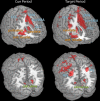Embedding reward signals into perception and cognition
- PMID: 20859524
- PMCID: PMC2940450
- DOI: 10.3389/fnins.2010.00017
Embedding reward signals into perception and cognition
Abstract
Despite considerable interest in the neural basis of valuation, the question of how valuation affects cognitive processing has received relatively less attention. Here, we review evidence from recent behavioral and neuroimaging studies supporting the notion that motivation can enhance perceptual and executive control processes to achieve more efficient goal-directed behavior. Specifically, in the context of cognitive tasks offering monetary gains, improved behavioral performance has been repeatedly observed in conjunction with elevated neural activations in task-relevant perceptual, cognitive and reward-related regions. We address the neural basis of motivation-cognition interactions by suggesting various modes of communication between relevant neural networks: (1) global hub regions may integrate information from multiple inputs providing a communicative link between specialized networks; (2) point-to-point interactions allow for more specific cross-network communication; and (3) diffuse neuromodulatory systems can relay motivational signals to cortex and enhance signal processing. Together, these modes of communication allow information regarding motivational significance to reach relevant brain regions and shape behavior.
Keywords: attention; executive function; fronto-parietal; motivation; posterior cingulate cortex.
Figures



References
Grants and funding
LinkOut - more resources
Full Text Sources

